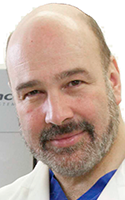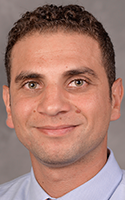By Deborah Jeanne Sergeant

Estimates for testicular cancer are approximately 9,310 new cases diagnosed in 2018 and 400 deaths, according to the American Cancer Society. About one out of every 250 men will develop testicular cancer at some point during their lifetime.
Unlike many cancers, it strikes mostly young and middle-aged men at an average of age 33. Only 6 percent of cases are in children and teenagers and men over age 55 comprise only 8 percent. Also uncommon is its high likelihood of successful treatment. As with most cancers, early detection and treatment improves the chances of good outcome.
“The way people present is they feel a lump on a testicle,” said David Albala, urologist with AMP Urology. “Guys essentially notice a mass that came up suddenly. Most guys feel a lump and typically come in to get it examined.”
Pain in the scrotum could indicate testicular cancer, according to the urologist.
About one-third of cancers are caught once metastatic, meaning they’re spreading elsewhere. A blood test and CT scan of the abdomen can indicate if the cancer has spread to other areas. Albala said those lymph nodes are “landing sites” for cancer.
But despite its spreading, Albala said it’s about 90 percent curable.
The reason is that testicular cancer is very sensitive to chemotherapy, even in the advanced stage; however, the severity and cost of treatment increases if the disease has advanced.
Most doctors recommend removal of the diseased testicle, as European doctors have attempted testicle-sparing approaches with little success. Sparing the testicle increases the chances of the cancer spreading to the lymph nodes.
“It’s usually removed through the groin,” said Joseph Jacob, urologist and assistant professor of Urology at Upstate Medical University. “The testicle and the blood supply to it is removed.”
Afterwards, a CT scan can help determine the stage of the cancer, which helps patients and physicians decide the next step. If further treatment is warranted, it’s usually chemotherapy and seldom radiation, since the latter can cause secondary cancers.

Jacob said that testicular cancer has good “tumor markers” that can indicate through a blood test if the cancer has spread to other areas of the body.
After surgery and any follow-up treatment, men visit their doctor periodically for blood tests to ensure that the cancer has not returned.
Although men with one testicle can still father children, the chemotherapy may cause infertility, and it can affect the nerves that cause semen to ejaculate (although erections still occur).
Risk factors include a non-descended testicle at birth, a factor for one out of 1,000 boys.
Caucasian ancestry is also a risk factor.
A man with a previous testicular cancer has a higher risk in developing cancer in the remaining testicle, which is why banking sperm is a good idea for men who still hope to father children after treatment for testicular cancer.
“I always talk with them about that for sure,” Jacob said.
Both Albala and Jacob recommend monthly self-exams in the shower. Men should feel for any abnormalities such as hardness, increased size, bumps and lumps. Both testicles should be soft and the same size.
“It’s usually in young men, but most of the time we can cure it,” Jacob said. “You have to treat it in a timely fashion and with people who know how. You should see a urologist with a cancer center that has seen this disease and take a multi-disciplinary approach.”
